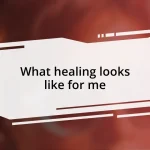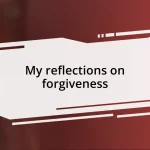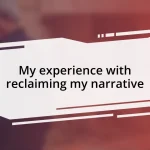Key takeaways:
- The impact of abuse affects not only the body but also the mind, leading to feelings of isolation and difficulty in trusting others.
- Healing is a non-linear journey involving awareness, acknowledgment, and self-reflection, often documented through journaling.
- Building a supportive network and setting healthy boundaries are crucial steps in reclaiming one’s life and promoting personal growth.
- Exploring various therapeutic approaches, such as mindfulness, art therapy, and self-care strategies, aids in emotional healing and resilience.

Understanding the Impact of Abuse
The impact of abuse can feel like a heavy cloak draped over every aspect of life. I remember sitting in a crowded room, yet feeling utterly alone, my mind echoing with whispers of shame and confusion. Have you ever felt that sense of isolation, even when surrounded by people who care? It’s a powerful reminder that abuse doesn’t just affect our bodies; it scars our minds and spirits, altering how we see ourselves and the world.
It’s striking how trauma influences our relationships. I often found myself second-guessing every interaction, wondering if trust was a luxury I could no longer afford. Isn’t it heartbreaking to think that the very people we crave connection with may become sources of anxiety instead? This distorted lens, shaped by past experiences, not only keeps us isolated but can also lead to repeating unhealthy patterns in our lives.
Every survivor carries their own story and resilience. For me, the smallest victories, like finally speaking up about my feelings, became monumental milestones. Can you recall a moment when you felt the weight of your past begin to lift, even just a little? Those moments, though often fleeting, remind us that healing is not linear but a journey marked with ups and downs, where understanding the impact of abuse is the first step toward reclaiming our lives.

Recognizing the Healing Process
Recognizing the healing process is an essential part of recovery, and it often starts with awareness. I remember vividly the moment I realized I was not who my trauma defined me to be. There was a strange mix of relief and fear in that realization. Have you ever caught yourself in a moment of clarity that pushed you to confront your pain? It’s a sign that healing is already underway.
The journey of healing can be deeply personal, with no singular map to guide us. For me, acknowledging that healing ebbs and flows felt like uncovering an essential truth. I’ve had days of sudden clarity when I felt powerful and in control, followed by days when even getting out of bed seemed like an insurmountable task. I learned to embrace this unpredictability, understanding that recognizing where I was in my healing journey was key to moving forward.
Tracking progress in healing is like watching the seasons change. At times, I found myself feeling a rush of hope, surfacing glimpses of joy, while other days revealed old wounds needing attention. I began keeping a journal, which became my silent witness to both despair and triumph. This practice not only validated my feelings but provided me with a clearer picture of my growth over time. Have you ever documented your feelings? It can be an eye-opening experience that sheds light on the complexities we navigate during recovery.
| Stages of Healing | What It Feels Like |
|---|---|
| Acknowledgment | Realizing the trauma is part of my past, not my identity. |
| Acceptance | Embracing that healing isn’t linear, with ups and downs. |
| Growth | Seeing signs of progress, like newfound confidence and joy. |
| Reflection | Documenting my journey to better understand my emotions. |

Building a Support Network
Building a strong support network can feel daunting, especially after experiencing abuse. I remember my hesitation the first time I reached out to a close friend about my past. I feared judgment, but instead, I was met with compassion and understanding. This taught me that genuine connections could transform vulnerability into strength.
Creating a support network doesn’t have to be a big, overwhelming task. Here are some steps that helped me:
-
Identify Safe People: Consider friends or family members who are empathetic and reliable. Who in your life makes you feel heard and understood?
-
Start Small: Share bits of your story gradually. I found starting with lighter topics made it easier to open up later.
-
Seek Professional Help: Therapists and support groups can provide expert guidance. I attended a local support group, and it was liberating to see others sharing similar experiences.
-
Engage in Community: Look for places where you can connect with people who have gone through similar situations—whether it’s online forums or local meet-ups. I found solace in a book club that focused on healing through literature.
-
Practice Self-Care: Surround yourself with activities and people that uplift you. I made a commitment to spend weekends doing hobbies that brought me joy, allowing me to recharge.
Each connection I built became a thread weaving into my tapestry of healing, reminding me I was never alone in my journey.

Exploring Therapeutic Approaches
Exploring therapeutic approaches is like finding the right keys to unlock different parts of your healing journey. I ventured into various therapies, experimenting until I found what resonated with me. Cognitive Behavioral Therapy (CBT), for instance, taught me to challenge negative thought patterns. Have you ever caught yourself spiraling into self-doubt? I learned to interrupt those cycles, replacing them with empowering thoughts, which felt like reclaiming a piece of my power.
Art therapy was another unexpected treasure on my path. The first time I put brush to canvas, I felt a flood of emotions pour out. Instead of worrying about creating something beautiful, I journeyed into the messiness of my feelings. It was liberating! I created an abstract piece that mirrored my inner turmoil, and from that chaos emerged clarity. How often do we underestimate creative expression as a healing tool? For me, it opened a door to feelings I hadn’t yet processed.
Lastly, I discovered the healing potential of mindfulness and meditation. At first, sitting quietly with my thoughts felt daunting—was I ready to face the storm inside? Yet, as I persisted, those sessions became anchors, grounding me in the present. I remember a moment when I simply observed my racing thoughts without judgment. It was profound, a reminder that my mind didn’t have to control me. Have you tried mindfulness? Taking those moments helped me cultivate a sense of peace amidst the chaos.

Practicing Self-Care Strategies
Practicing self-care strategies was a game changer for me. After the ordeal I had faced, I realized the importance of nurturing my body and mind. I started with simple things, like taking long walks in nature. Some days, I’d just feel the fresh air on my skin and listen to the rustling leaves. It became my safe space—a moment to reconnect with myself. Do you have a place that grounds you?
Mindfulness practices also crept into my routine. Initially, I felt resistance. I often thought to myself, “How can I sit still when my mind is racing?” But I discovered that allowing myself to just be, even for a few minutes, unfolded layers of calm I didn’t know existed. I remember one evening, I lit a candle and turned off my phone. It felt incredible to have that intentional quiet, and for the first time in a long while, I felt peace seep into every corner of my being.
Incorporating self-compassion was perhaps the most transformative strategy. I had spent years being critical of myself, which only deepened my wounds. When I started to treat myself like a friend—offering kindness on difficult days—my perspective shifted. I remember mornings when I’d look in the mirror and say, “You are enough, just as you are.” It might sound cliché, but those small affirmations opened the door to a more profound acceptance of my journey. Have you ever tried speaking kindly to yourself? It truly can change everything.

Setting Healthy Boundaries
Setting healthy boundaries became a vital part of my healing process. I once found myself in situations where I felt overwhelmed, often saying “yes” when I really wanted to say “no.” It took some time to realize that establishing limits didn’t mean I was being selfish; in fact, it was an act of self-love. Have you ever hesitated to assert your needs for fear of disappointing someone? I can assure you that prioritizing your well-being is crucial.
One memorable experience was during a gathering with friends. I noticed that certain conversations triggered old wounds. Rather than staying silent, I calmly expressed, “I need to step away from this topic,” and took a moment to breathe. Surprisingly, my friends respected my request. It taught me that being transparent about my boundaries helped maintain healthier relationships. How freeing it is to reclaim my space and voice!
As I deepened my understanding of boundaries, I found myself more confident in communicating my feelings. I remember a conversation with a family member who would often compare my progress to others. I gently said, “I appreciate your concern, but I need to focus on my own journey.” Their surprised expression was a reminder that my growth was mine alone to navigate. It felt uplifting to stand firm in my truth. Isn’t it empowering to know that setting boundaries can foster deeper connections?

Embracing Personal Growth and Resilience
Embracing personal growth after my abuse was an eye-opening journey. I vividly remember a moment when I signed up for a pottery class, something I’d always wanted to do. The act of molding clay was not just creative; it symbolized my ability to reshape my life. Each piece I crafted reminded me that I could transform pain into beauty. Have you ever found a hobby that helped you discover parts of yourself you didn’t know existed?
Resilience isn’t just about bouncing back; it’s about growing from the experience. There were days when I felt like I was stuck in quicksand, but journaling became my lifeline. I would write down my thoughts, fears, and small victories. I recall one entry where I celebrated the courage it took to speak up about my story for the first time. That simple act allowed me to reclaim my narrative, which felt incredibly empowering. Have you ever considered how sharing your story could add to your resilience?
As I embraced this journey, I encountered setbacks, of course. I remember a particularly tough week when sadness crept in like an unwelcome guest. Instead of spiraling, I allowed myself to feel those emotions without judgment. I took a moment to breathe and remind myself: “This is part of the process.” It struck me that acknowledging my feelings was a significant step towards healing. Isn’t it fascinating how our vulnerabilities can pave the way for a stronger self?














